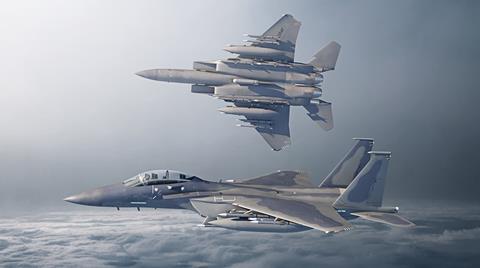Boeing believes the advanced manufacturing techniques used to build its F-15EX will give it an edge in a competition for the US Air Force’s (USAF’s) next-generation fighter programme, known as the Digital Century Series.
The USAF awarded Boeing a $1.2 billion contract to build a first lot of eight F-15EX aircraft, it was announced on 13 July. The deal is the first tranche of what could be a $23 billion programme for at least 144 examples of the fighter, with the option to buy up to 200 aircraft.

The programme win is a coup for Boeing. The company convinced the service that it would be cheaper and easier to buy the F-15EX, rather than the stealthier Lockheed Martin F-35 Lightning II, which the USAF usually prefers to buy.
Much of Boeing’s winning argument was focused on the lower cost per flight hour of the F-15EX. The fourth-generation aircraft has a $29,000/h cost, while the F-35 costs as much as $44,000/h, the USAF has said. Because the F-15EX is going to replace ageing F-15C/Ds, the service believes commonality between the two jets will also allow for easier transition of pilots and maintenance personnel within squadrons. Moreover, the aircraft’s ability to carry a hypersonic missile weighing up to 3,180kg (7,000lb) and measuring up to 6.7m (22ft) in length under its centreline was an added bonus.
Nonetheless, Boeing argues the F-15EX is more than a less-expensive stopgap. The company says much of the Cold War aircraft, as well as its manufacturing process, has been re-engineered since the F-15E was last delivered to the service more than 20 years ago. That revamp makes the aircraft into a “pathfinder” for future fighter aircraft development.
In particular, Boeing is transposing the F-15EX’s structural design into meticulous, fully digital 3D models, including the aircraft’s nose barrel, wings and soon its forward fuselage. That has allowed some precision work to be outsourced, for example, the drilling of holes for fasteners.
“The reason it’s possible is because digital engineering has fully 3D model parts which can be manufactured in a supply base in a very precise manner,” says Prat Kumar, Boeing vice-president and F-15 programme manager. “When you bring [the parts] into the factory, it all comes together magically and all the hundreds of thousands of holes lined up in the assembly area.”
The company says the process eliminates cost, is faster and creates supply chain options.
“What it does is eliminate the handling of the holes in the factory [and] eliminates shimming. The tolerances are very good,” says Kumar. “When we did the nose barrel, after the initial learning curve, it really led to almost a 70% reduction and touch labour in the workshop.”
Having multiple suppliers might also create competition, which could be advantageous, he adds.
“It certainly provides flexibility in the supply chain as long as our supply base is equally enabled with 3D modeling capabilities and advanced CNC manufacturing,” says Kumar.
The fully digital models of the jet might also allow Boeing to integrate new components faster by doing virtual testing. And, replacement parts could be CNC-machined or 3D-printed on demand, allowing for faster and less-expensive maintenance of the aircraft.
The ability to quickly create parts and add new components to an aircraft is at the core of the USAF’s Digital Century Series strategy. Using advanced manufacturing techniques, such as digital engineering, the service imagines buying a new fighter aircraft about every five years. It hopes it can fold in new technologies to each new design in the series in order to innovate faster than rivals China and Russia.
The USAF also envisions using open systems architecture and agile software development methods to quickly integrate new programmes into fighter aircraft.
Boeing says the fly-by-wire F-15EX has been upgraded with a powerful mission computer and an open system architecture, which is designed to allow easy integration of third-party applications and hardware. The programme is also transitioning to agile software development methods, the company says.
“The digital backbone, along with open mission systems and agile software development, really forms the Holy Trinity that allows us to rapidly test new capabilities on this jet,” says Kumar.
One new capability Boeing may eventually incorporate into the F-15EX is manned-unmanned teaming. The company is currently developing a loyal wingman unmanned air vehicle (UAV), called the Airpower Teaming System, that could be paired with the jet.
Controlling a loyal wingman UAV could be done from the back seat of the F-15EX. However, at least in the short term, the USAF does not plan to place a pilot in the back seat of the combat aircraft. The aircraft upon which the F-15EX is based, the two-seat Advanced F-15 – being produced for Qatar and Saudi Arabia – is a two-seat configuration. The USAF needed a replacement jet so urgently it did not want to wait for Boeing to design a single-seat version of the F-15EX. Instead, the aircraft will be flown solo from the front seat.
“The air force can decide to use a second cockpit for whatever they want,” says Kumar. “We have heard about adding artificial intelligence to the jet. We can certainly consider using that [second-seat] space and capability on the jet.”
Aside from its fly-by-wire controls, most of the F-15EX’s new capabilities can be retrofitted as upgrades onto older examples of the F-15, says Boeing. The company says it is responding to a request from Israel to buy 25 additional fighters and upgrade its current 25 F-15Is.
Boeing is also working toward offering the F-15EX to India for that country’s air force requirement for 110 fighters. The company has yet to receive a marketing license from the US government to start direct discussions with New Delhi, however.
The F-15 programme has enough orders to keep the production line active beyond 2030. Boeing says it is scheduled to deliver the first example of the F-15EX to the USAF in the first quarter of 2021.































